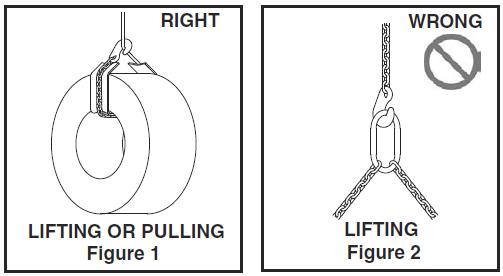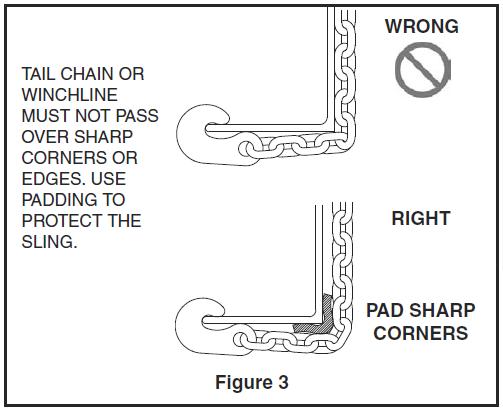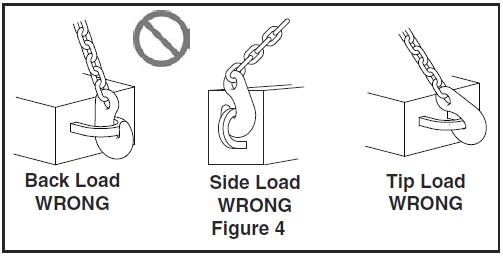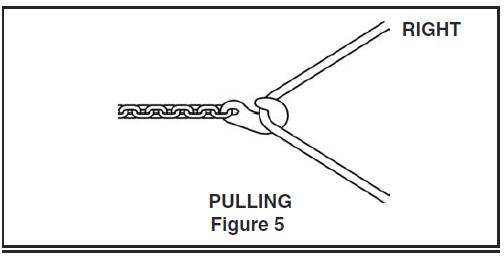Winchline Tail Chain Lebus L-180
LEBUS L-180 WINCHLINE TAIL CHAIN WARNING AND APPLICATION INSTRUCTIONS
WARNING_ |
- Loads may disengage from winchline tail chain if proper procedures are not followed.
- A falling load or disengaged winchline tail chain may cause serious injury or death.
- Inspect winchline tail chain for damage before each use.
- Wire rope should not be terminated to tail chain by the use of a knot.
- Do not attach slings or other devices in hook for overhead lifting - see operating practice.
|
Important Safety Information -Read & Follow
- Only winchline tail chains made from alloy chain, grade 80 or grade 100, should be used for overhead lifting applications.
- Working Load Limit (WLL) is the maximum load in pounds which should ever be applied to winchline tail chain.
- The Working Load Limit or Design Factor may be affected by wear, misuse, overloading, corrosion, deformation, intentional alterations, sharp corner cutting action and other use conditions.
- Never repair, alter, rework, or reshape a hook or chain by welding, heating, burning or bending.
- Recommended for IPS or XIP (EIP), RRL, FC or IWRC wire rope.
- Shock loading and extraordinary conditions must be taken into account when selecting winchline tail chains.
CAUSE FOR REMOVAL FROM SERVICE
- A winchline tail chain shall be removed from service if any of the following are visible on chain or hook.
- Wear, nicks, cracks, breaks, gouges, stretch, bend, weld splatter and discoloration from excessive temperature. Minimum thickness on chain link shall not be below the values listed in Table 1.
Table 1 |
L-180 Stock No. |
Wire Rope Diameter (in.) |
Nominal Chain Size |
(in.) |
(mm) |
1091473 |
5/16 — 3/8 |
3/8 |
10 |
1091482 |
1/2 — 5/8 |
5/8 |
16 |
1091511 |
3/4 — 7/8 |
7/8 |
22 |
1091516 |
1—1-1/8 |
1 |
26 |
1091525 |
1—1-1/8 |
1 |
26 |
1091532 |
1-1/4 |
1-1/4 |
32 |
- Wire rope termination efficiency and tail chain Working Load Limit (WLL) must be considered when selecting termination fitting and tail chain.
- Efficiency of wire rope end termination is based on the catalog breaking strength of wire rope.
Typical Termination Method & Efficiency |
Termination |
Efficiency |
S-409 Swage Button |
80% |
- The winchline tail chain hook is designed to fit the winchline diameter when hooked or connected back to winchline (See Figure 1).
- When used to pull or drag a load, the winchline tail chain may be wrapped around the load and the hook connected to the winchline. Also, when used to pull or drag a load over the tail board roller, the tail chain hook may be attached directly to the load at a connection point authorized by a competent rigger (See Figure 5). In either case, a visual verification of proper hook engagement is required during the entire operation.
- When used in overhead lifting applications, the winchline tail chain may be wrapped around the load and the hook connected to the winchline (See Figure 1). Used in this manner, this connection provides the same load control advantages and limitations as a single leg wire rope sling basket or choker hitch. The winchline tail chain should contain and support the load from the sides, above center of gravity, so load remains under control. A visual verification of proper hook engagement is required during the entire operation.
- The tail chain hook has no provision for a latch; therefore, The Crosby Group, Inc. specifically recommends AGAINST placing the load, slings or other devices directly into the tail chain hook for the purpose of overhead lifting. A latch may be mandatory by regulations or safety codes: e.g. OSHA, MSHA, ANSI/ASME B30, insurance, etc. (See Figure 2).
If the above Crosby recommendation is disregarded and slings or other devices are placed directly into the tail chain hook, as a minimum ensure:
- Personnel shall stand clear of the suspended load.
- Visual verification of proper hook engagement is required in all cases.
- The sling or device should be centered in the base (bowl/saddle) of the hook.
- The user must assure connection to the hook is secure throughout the movement of the load.
- A designated competent rigger must verify that all appropriate rigging practices are followed for attachment and control of load.
- The winchline and tail chain links should always be protected from being damaged by sharp corners (See Figure 3).
- Chain links should not be twisted or kinked.
- Winchline or tail chain should not be pulled from under loads if the load is resting on winchline or tail chain.
- Winchline or tail chain that appears to be damaged should not be used unless inspected and accepted by a designated person.
- Never side load, back load, or tip load hook (See Figure 4).
- Personnel, including portions of the human body, should be kept from between the winchline / tail chain and load.
- Personnel shall stand clear of the suspended load.
- Shock loading should be avoided.
- Extreme temperature will reduce the performance of winchline tailchain.
- Normal operating temperature is -40°F to 400°F (-40°C to 204°C).
|










